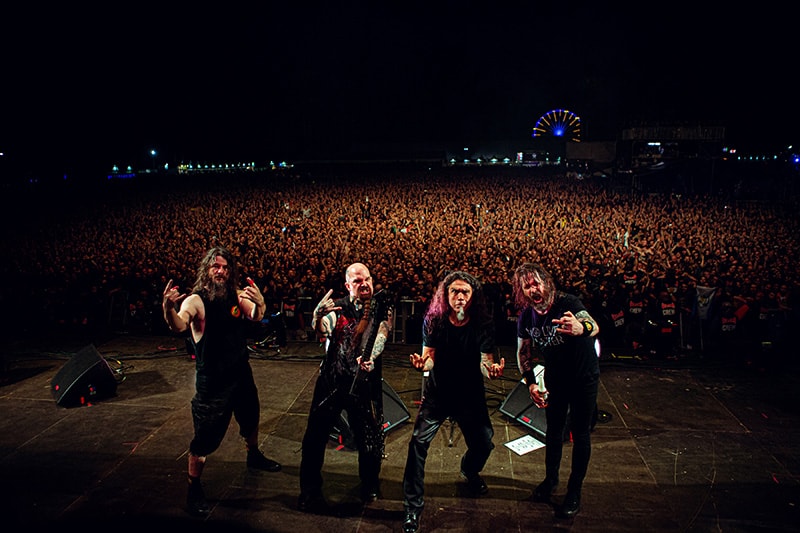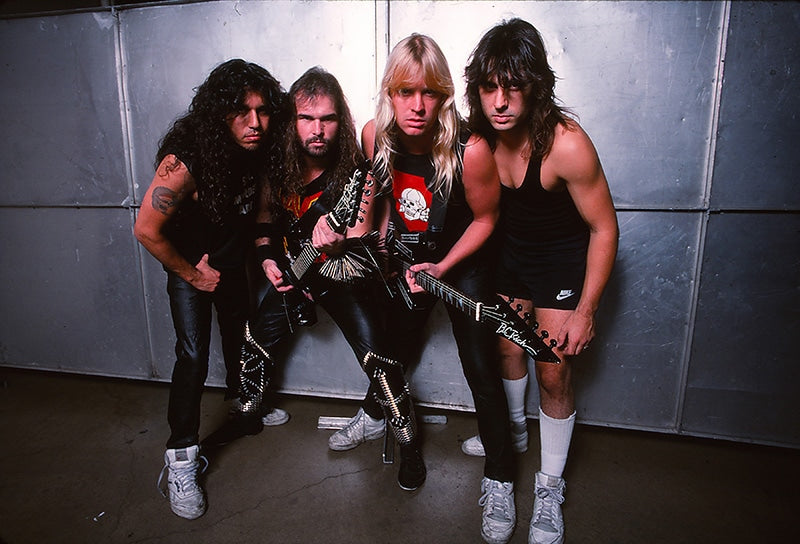This past May 2 marked the ninth anniversary of thrash metal guitarist Jeff Hanneman’s (1964 – 2013) passing at age 49. He was a founding member of Slayer, which formed in Huntington Park, California, and played continuously from 1981 to 2011. Due to health issues, Gary Holt of Exodus took over touring duties and played with Slayer after Hanneman died of liver disease. Slayer powered on through their final tour just before COVID-19 shutdown, and I got to see them one last time in 2017 before they disbanded two years later.
There I was at The Theater at Madison Square Garden as one of the aging metalheads. Some guys looked old and frumpy in their extra-large Slayer shirts. Some opted for weightlifting instead of beer-guzzling and appeared disturbingly buff for metal fans, while others, who presumably still enjoyed drinking heavily, bellowed “S-L-A-Y-Y-Y-Y-E-R!” across the venue to locate each other – I’ve been a charming mélange of all three categories. By that time, I had been listening for 26 years and I can pinpoint the day I became a fan: Saturday, April 6, 1991 – sometime around 2 am while watching MTV’s Headbanger’s Ball hosted by Riki Rachtman.
The show, which has been airing hard rock and heavy metal videos on one platform or another since 1987, coincided with the end of my restaurant shift as I rushed to the bodega for a few oil cans of Foster’s Lager and back to my studio apartment to catch as many bands as possible. I waited for videos by Ozzy Osbourne, Iron Maiden, and Motörhead and generally avoided newer material by Van Halen impersonators in fluorescent spandex, makeup, and big hair. The Ball seemed to get worse by the week as MTV incorporated more pop, more ballads, and more soft-metal from LA’s Sunset Strip.
Suddenly, an auspicious sound came out of my 2-inch TV speaker. Did Riki say the band was called Slaughter, or Slayer? The black and white intro lays an ominous foundation with the Sphinx, pyramids, and papyrus scrolls. Musicians I had never seen before appear first in a tomb and then on a single-sail barge being ferried across a foggy river. Shadowy figures build tension for two minutes and 22 seconds until a blue sky finally illuminates the screen. The blackness of the band’s clothing and hair (except for Hanneman, who was blond), instruments, and Marshall amp stacks create a stark contrast to the sun-bleached landscape. Filmed in tight frames and cropped images, the photographer creates a sense of claustrophobia even in the desert’s vastness. Slow motion shots capture band members while men on galloping horses mirror the tempo and increase chaos. The video makes it seem like we’ve been awake for 24 hours, but catharsis arrives at six minutes and 33 seconds: two camels stand in silhouette against the glow of the setting sun, and we are slowly released from the abyss unscathed.

Slayer, final world tour, 2019: Paul Bostaph, Kerry King, Tom Araya, Gary Holt. Courtesy of Tom Tronckoe.
“Seasons in the Abyss” from the album of the same name reminded me of the opening scenes of The Exorcist (1973) filmed in Iraq, combined with the video of Love’s “Alone Again Or” (1987) performed by The Damned. From then on, I stayed up late every Saturday night to see Slayer, wading through hours of fluff. Having made only six music videos, Slayer were live performers, not screen actors, and it would have been unimaginable to see them partying in a strip club with models, pretending to be a rock and roll street gang in motorcycle chaps, or pantomiming B-movie horror scripts. Austrian director Markus Blunder conveyed the dark sensibility of the song without violence or gore but by tapping into our own imaginations with locations and symbols to flesh out the few discernible lyrics:
“Close your eyes
Look deep in your soul
Step outside yourself
And let your mind go”
The video could have been filmed in California’s Death Valley with stock footage of the Giza Necropolis inserted, but it wasn’t. According to the Rolling Stone article “Slayer Reflect on ‘Seasons in the Abyss’ Egyptian Video Odyssey” by Kory Grow (May 20, 2016), Rick Rubin came up with the idea to shoot in Cairo, Egypt. A tall order, but as Slayer’s producer and president of Def American Records at the time, Rubin could make that happen – and just before UNESCO, the Egyptian government, and archeologists recommended limiting further potentially destructive activity at the 4,500-year-old site.
Egyptian antiquities perfectly express the song’s mystery, and it wouldn’t have been as magnificent if filmed anywhere else. Blunder weaves a thrash song into a fabric of hieroglyphs and archetypes of sun, fire, desert, and river. He seems to have a knack for filming in nature, as you get a sense of the wind as it coats the drum kit with a layer of sand.
The embodiment of Slayer as a live band can be seen between 2:22 and 6:00 into the video, with singer/bassist Tom Araya in the forefront, Dave “Godfather of Double Bass” Lombardo on drums, and Hanneman and Kerry King trading leads on guitars. At 4:11, Araya does some monumental headbanging which hooked me completely. I went right to Tower Records and bought the CD of Seasons in the Abyss, their fifth out of 12 albums spanning their career, which started me on a journey into Slayer’s early records as well as future releases.
As a lifelong prog-rock fan, this was my first descent into the depths of Slayer’s songwriting, covering subjects related to war, religion, and people like Jeffrey Dahmer and Ed Gein. It does beg the question as to why anyone would create or listen to such bleak material. While Stephen King and John Carpenter invented tales of terror, Slayer’s songwriters reflected the world back to us from their own vantage points – Tom Araya is a practicing Catholic, Kerry King is an anti-theist, and Jeff Hanneman came from a family of war veterans. Functioning in the same way as horror stories, myths, and fairy tales, Slayer’s music opens a portal to nightmares and allows us to confront, reconcile, and relieve the anxiety around our collective fears.
I still listen to thrash metal – especially as I memorialize Jeff Hanneman, and recall the early days of music videos. After watching “Seasons in the Abyss” for the hundredth time, I’m still amazed at its style, impact, and fresh appearance after 31 years. While so many videos from the era have aged terribly, the Slayer/Blunder collaboration on the Nile River and Giza Plateau stands apart from modern time and place. Seasons continues to engage the emotions, unconscious, and intellect, like any enduring and evocative work of art that lets us step outside of ourselves and let our minds go for a bit.
Header image of Slayer in the 1980s courtesy of Neil Zlozower. Left to right: Tom Araya, Kerry King, Jeff Hanneman, Dave Lombardo.



